comes from the Latin mutare (to change), from the Proto-Indo-European root *mei- ‘to change, go, move’. Mutare shares the same root as the Sanskrit methati ‘changes, alternates, meets’ and the Latin meare (to go, pass) and migrare (to move from one place to another), in English ‘to migrate’.
This piece is a series of short reflections around the permeability between the words ‘migration’ and ‘mutation’. Linked together by three contemporary artworks loosely clustered around the geographies of the high North, it interrogates art’s relationship to movement in its dispersed and political forms.
1.1 The Mountain Woman walks as if afloat.
On the Grey Dunes of the Curonian Spit, two kilometers from the Lithuanian and Russian border, our phones pick up signals from the Russian telecommunication network. Hello, she says, and Welcome to Russia. The Mountain Woman floats across complicated circuits. Born of male poets at the beginning of the Icelandic independence movement in the early nineteenth century, she, Fjallkona is the fertile, feminine body of the nation and its wet dream. For the Icelandic independence movement, an obsession with a return to the settlement narrative successfully elides the years of Danish colonial rule. It is this narrative that the Landráð performances split open.
1.1 The topographical body is a vulnerable thing.
In Bryndís Bjornsdóttir’s Landráð II (treason in Icelandic), she flamenco loops in a pink raincoat, her calves smeared with tar. This 2017 performance in Lithuania affectively explores movement, alerting us to the fluidity of the shifting boundaries of the nation state. The Grey Dunes that are Lithuanian today, have been home to crusading military orders, fishing villages under Prussian and German empires, artist colonies, and a controlled holiday region reserved for the Soviet elite. Due to deforestation by overgrazing and the commercial harvest of timber, sand dunes completely took over the Curonian Spit in 1757 and its moving sands buried whole villages. Labour-intensive reforestation efforts were initiated by the Prussian government in 1825 as a crisis management strategy. Bjornsdóttir’s performance links the moving sands of the resort town Nida (fluent in the Old Prussian language) with the black sands of Iceland, where current reforestation narratives have sought to return Iceland to its imagined, original state of 9th century settlement. The ability to move and drag things with it is the fluent sand’s most powerful weapon.
It is a well rehearsed fact that over stretches of geologic time, the action of winds reshuffles and floats sands and dust and a range of aerosols with no attention to political borders. But what sort of politics do we turn to when the boundaries between earth and sky dissolve? What is our feminist manifesto between changes of state? When the mountain woman walks, she floats.
1.2 Sensing the insensible
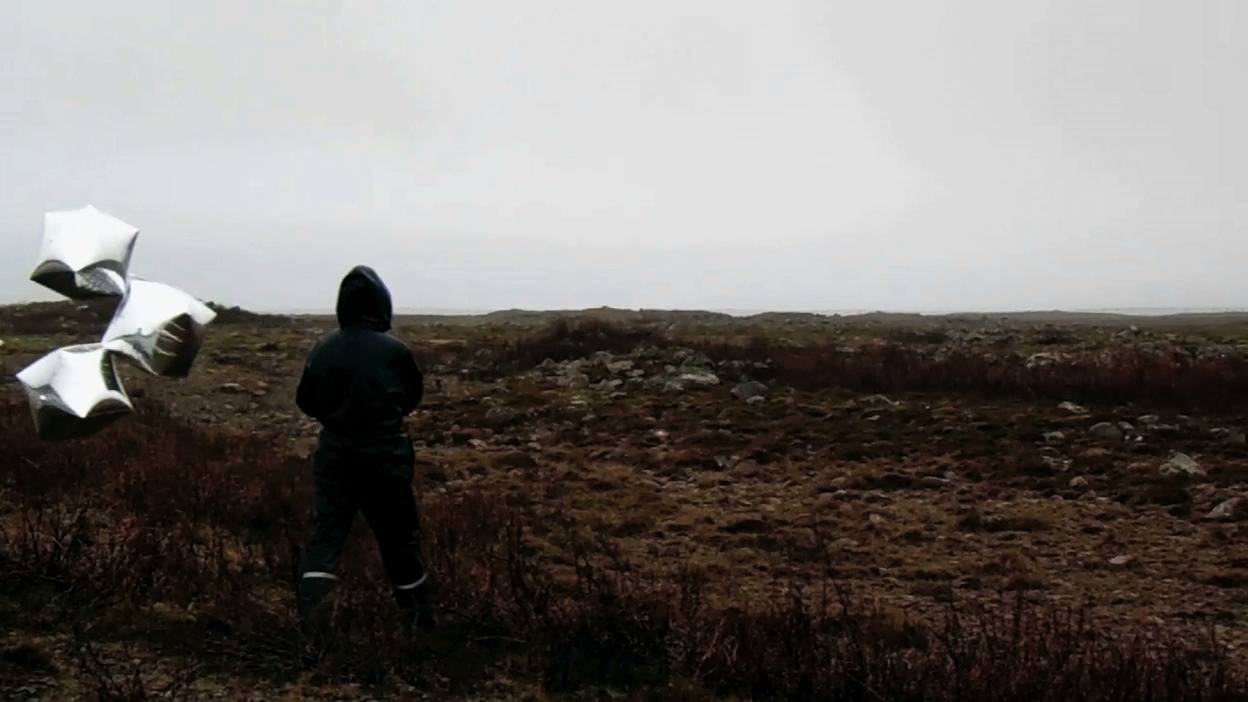
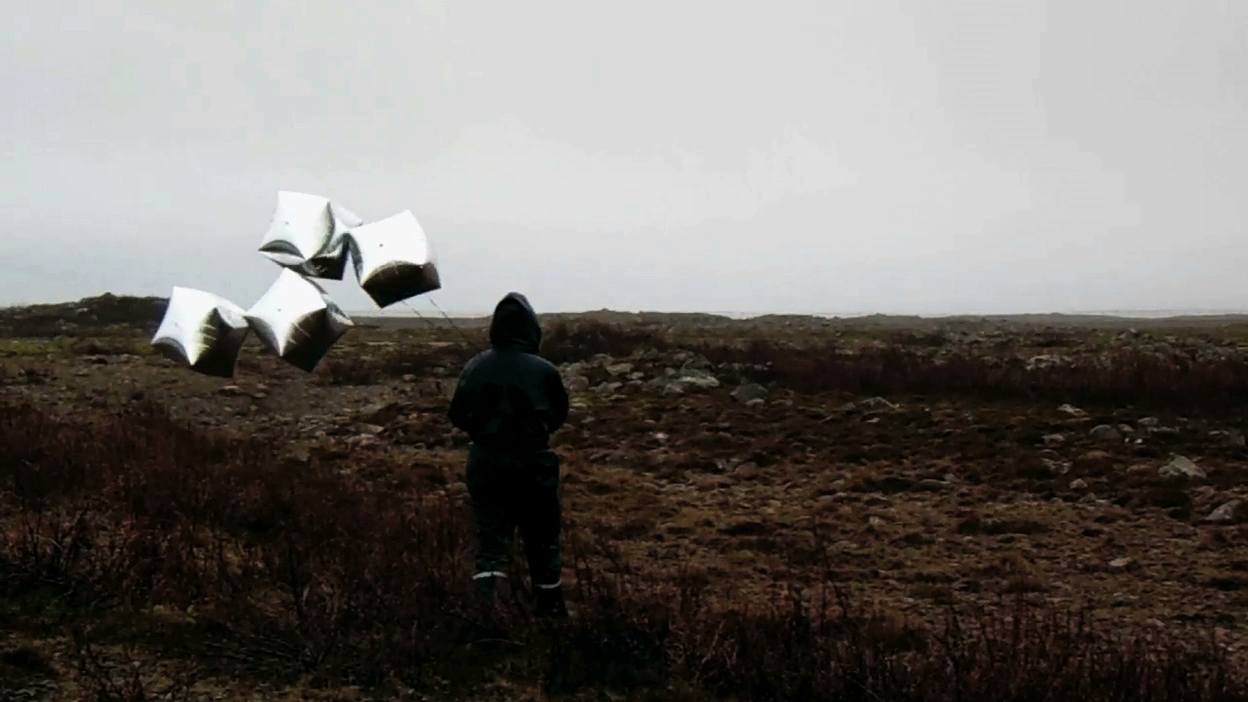
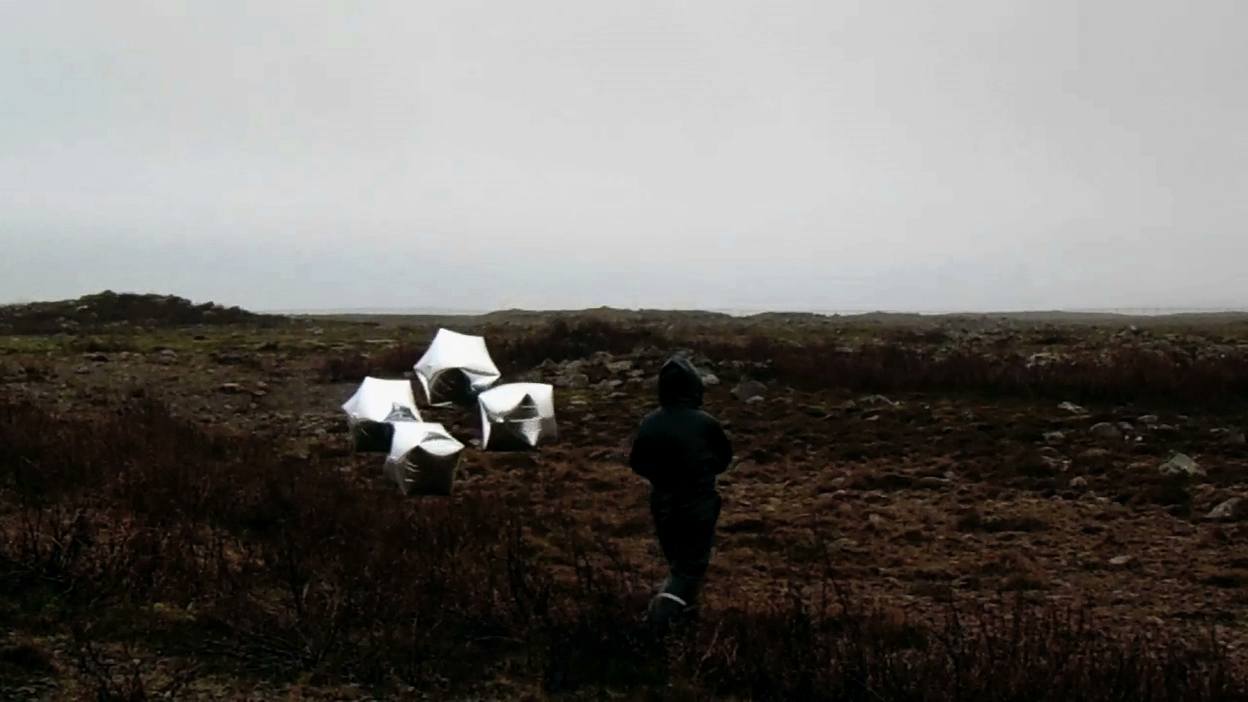
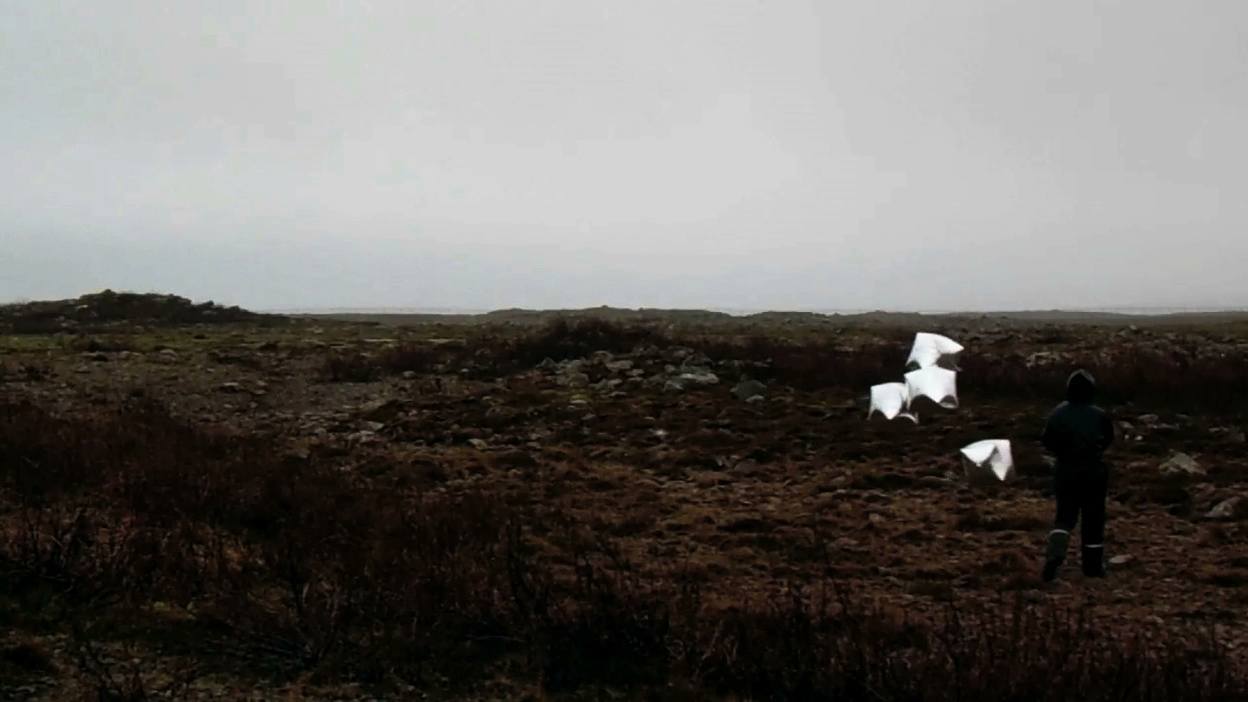

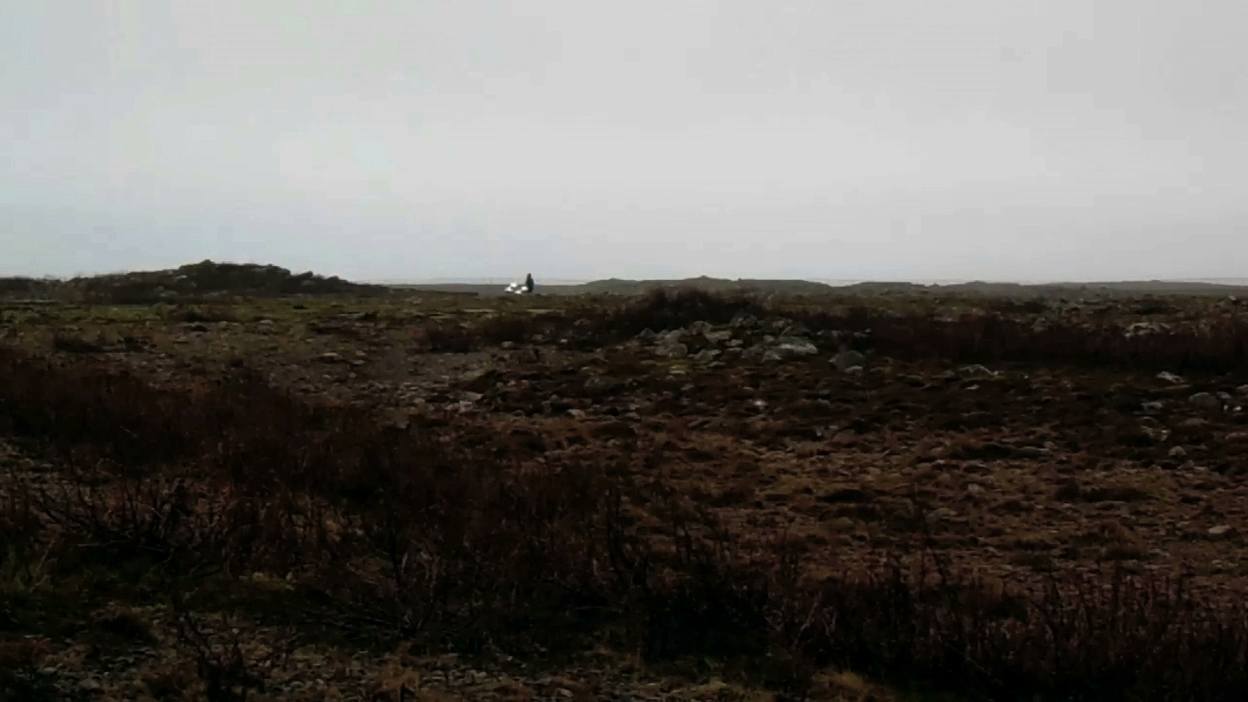
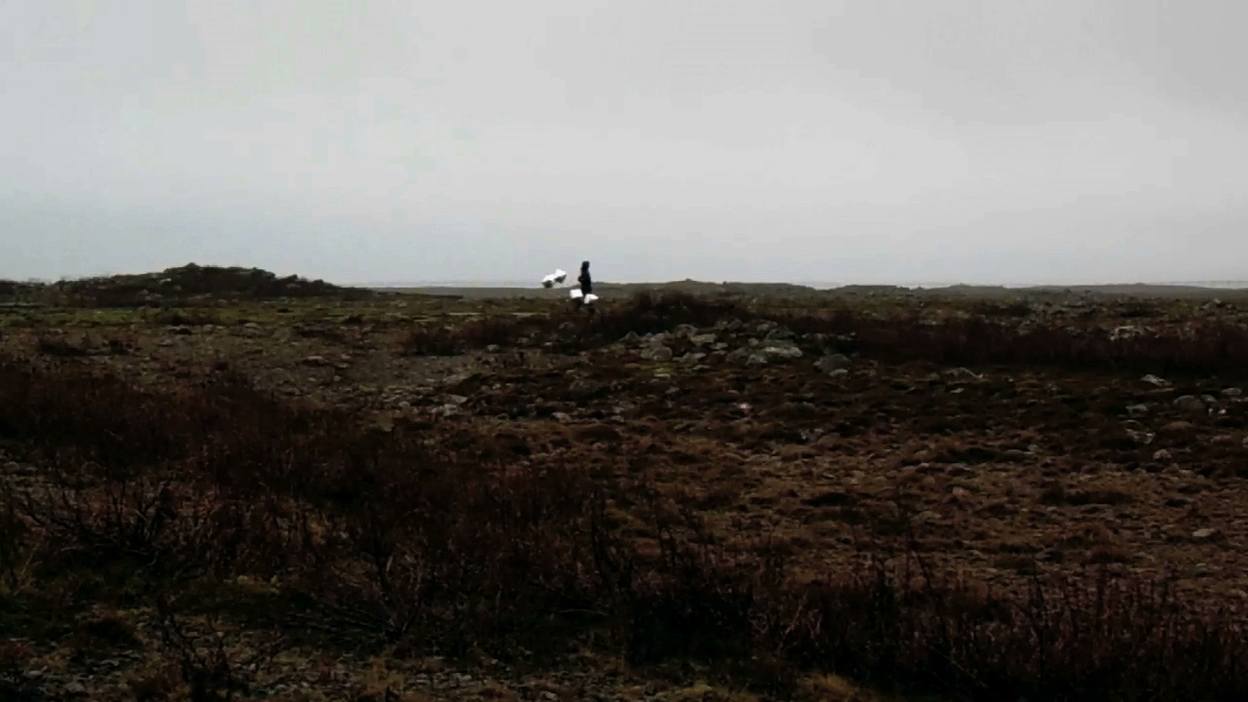
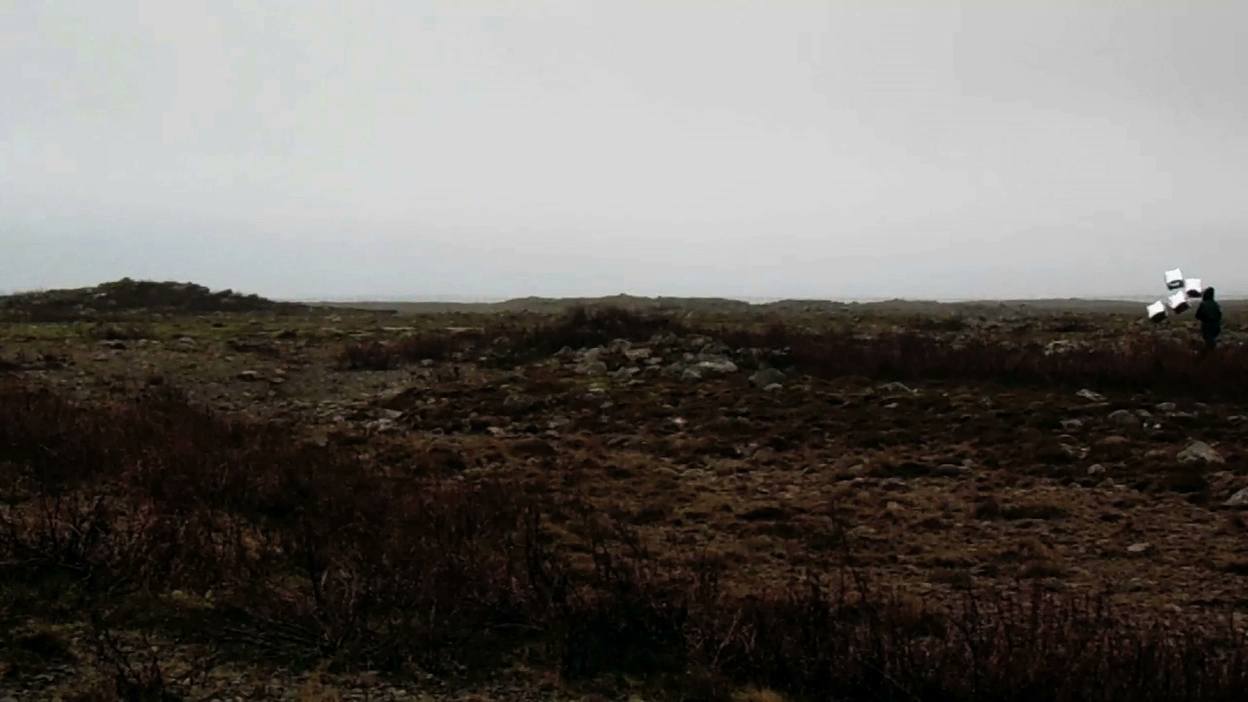
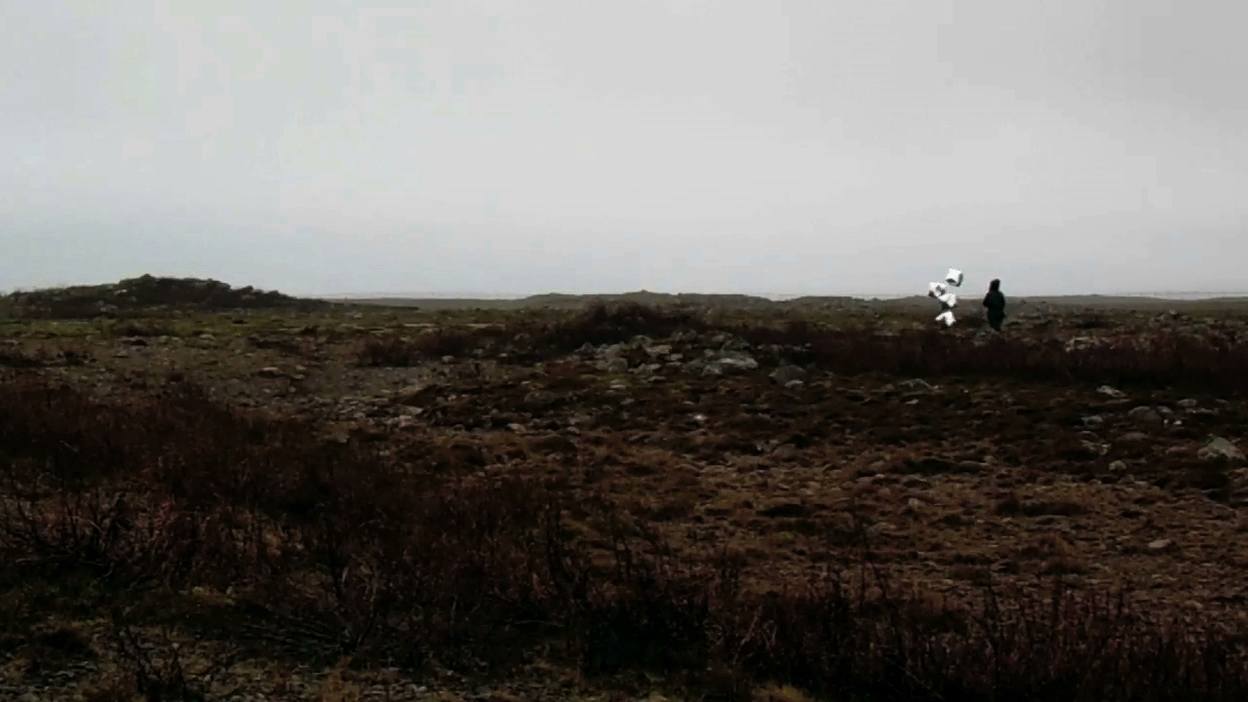
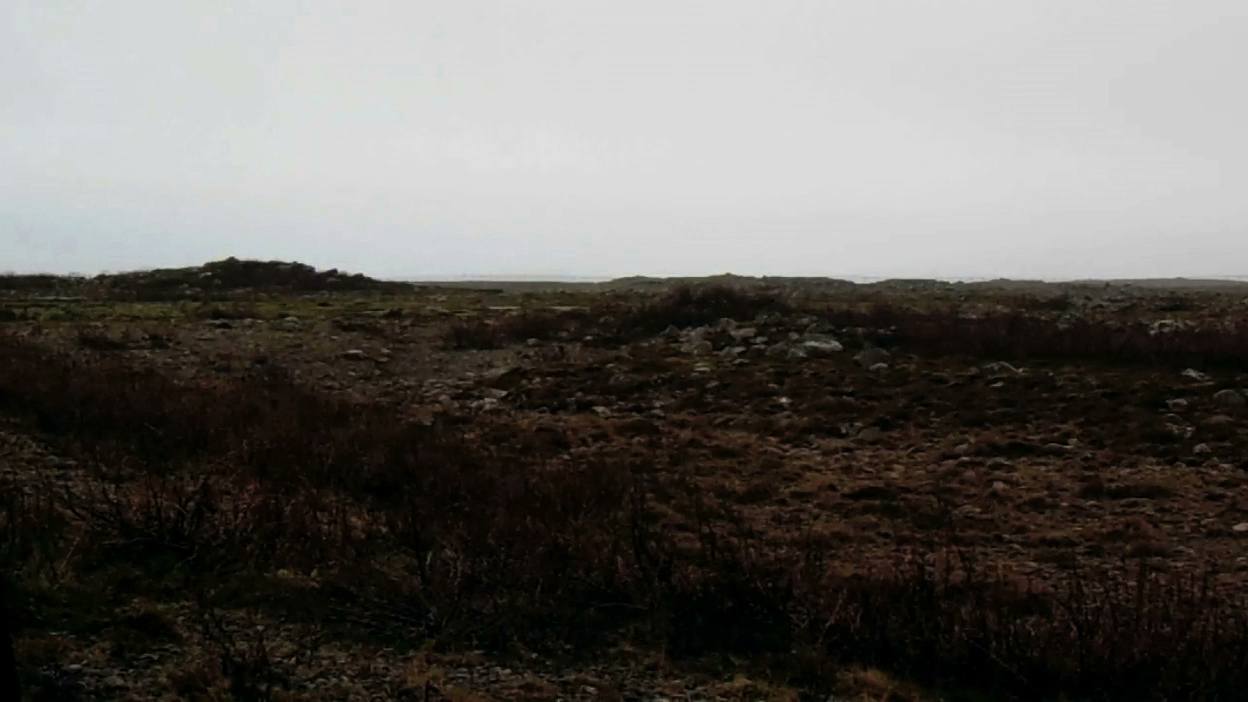
Walking is an integral part of Bjornsdóttir’s practice. Rebecca Solnit’s history of walking observes that women’s walking is often construed as performance rather than transport, with the implication that women walk not to see but to be seen. In Icelandic storybooks, when the Icelandic people settled in Iceland, they were required to mark their territory. The ‘men marked their lands walking from sunset to sunrise with fire and women had to walk from sunset to sunrise with a two-year old cow.’ she says. ‘I reenacted different ways just walking, zigzagging different areas’.
In one iteration, the Landráð performance took place in the fluid lava fields of Ásbrú, a part of the former US checkpoint patrol position, now an abandoned Nato-base on Reykjanes, Iceland. The area of Ásbrú, which is currently being developed as a centre for technology and innovation is punctured by caves and tunnels filled with seawater, ocean waves, currents constantly move beneath the visible fields, allowing the landscapes to very subtly rise and fall. Bjornsdóttir (as Mountain Woman) dressed in a blue jumpsuit, strung herself to a floatable device of helium balloons that mapped her movements in the air. Her shiny objects in the sky were beacons of hope, drawn from a particular history of the high north where natural nacreous clouds in the winter polar stratosphere were often mistaken for UFOs. They act, at once, as beacons of the bizarre, of hope in possibilities beyond earth and sky, and tools for an alternative sensing of the environment. Scanning the surface of a lava field turned military wasteland, the Mountain Woman’s deliberate and careful walking is a performance, a gestural act of detoxifying the land, of feeling herself, of testing the fluidity of sedimented histories. If the Mountain Woman is both landscape and her own futile sensor, a woman, a construction of the male imagination, who is responsible for her dispersal, her floating away?
2.0 ‘Cloud’
from Old English clūd ‘mass of rock or earth’; probably related to clot. For their similarity in appearance the term was extended to include rain clouds, as masses of evaporated water in the sky. It has, since, become a metaphor of data storage – of the accumulation of nodes, infrastructure and shared services – obscuring its materiality through the figure of a cloud.
2.1 Clouds are inherently material,
yet they exist by disappearing. The prophetic capacities of clouds are undermined by their biological needs. Their thickened aerial spaces are living environments, offering atmospheric oases for airborne communities that thrive and actively grow in clouds, feeding on nutrients such as organic compounds and metals dissolved within cloud water. The cloudiness of seeing is an exercise in consumption, inescapably embedded in the infrastructures of survival and extraction.
2.2 What I see in the weather
The Arctic is particularly cloudy, especially in summertime, when the sea opens up, releasing minute particles of matter into the air, forming clouds. In the Vast Ocean of Air, floating ten thousand meters above the Arctic territory of Svalbard, the act of seeing is brought into question. Svalbard’s cloudiness bridges materiality with visibility, as it stresses air’s characteristic as a medium to transmit light and vibrations and to diffuse volatile and soluble chemicals. In the film, looking, at and through cloudspace is interrupted by views of the land. Deep panning shots from a ship glide across Svalbard’s geological forms and earthbound shots face up from mining sites over which the extended landscape machine of extraction hovers in screen-grabbing silhouette. Does looking into the weather force us to abandon learned definitions of the boundaries between cloudscapes, landscape, and what lies beneath?
2.3 The clouds fallout
‘It was understood that the nuclear bomb tests would spew significant amounts of radiation into the sky. It was however presumed that the plutonium would fission, and be thrust high into the atmosphere, where, supposedly, it would disperse. It did disperse. But it didn’t go away, and fallout radiation was detected at large distances from the blast.
Several kilograms of Strontium 90 were released in the world in less than a decade. This disseminated enough of the contaminant to provide amounts detectable in samples of matter throughout the world. The presence of radioactive debris provided a unique opportunity to follow the flow of matter, and to study atmospheric motions on both a hemispheric and global scale.’
– from Hanna Husberg’s Vast Ocean of Air
2.4 Archiving the weather
Svalbard’s landscape is well known for its archival qualities, having preserved the largest number geological periods in rock.
600 million years ago what would become Spitsbergen (the early name for Svalbard, in Dutch: jagged mountain) was situated on the opposite end of the globe, close to the South Pole. 350-400 million years ago, Svalbard had drifted to just a little north of the Equator and experienced a dry desert like climate before entering a wetter, more tropical climate in the Carboniferous period. Coal seams built up from plant fossils in central Spitsbergen developed in this period, and in the Lower Tertiary (or the Paleogene, about 66-23 million years ago).
2.6 Svalbard continued to drift.
It warmed, and faulted and volcanized, and as it drifted northward, it started to cool, helped by the global cooling of the Tertiary period. The continental drift will continue to move Svalbard northwards and eastwards and in 50 million years, it may lie closer to or at the North Pole.
This moving body has been a site for exploitation since the 1600s. Large scale extraction of whale and walrus was followed by coal mining, both accompanied by scientific research missions with diplomatic claims. Cruise ships and large scale tourism have most recently taken over Svalbard’s continuing history of extraction, and tourists are ironically promised ‘untouched arctic wilderness and unique wildlife in a setting that is both rugged and fragile at the same time.’ 1
- https://www.visitnorway.com/places-to-go/svalbard-islands/)
2.7 Mining the Archive
The Dutchman Willem Barentsz on his northern route to the Far East discovered Svalbard by chance in 1596, triggering its odd diplomatic history. Until the first world war, Svalbard was terra nullius, no man’s land. This mobile, active, resource-rich spirited landmass was free – for all nations to whale and hunt in, and quibble over, and they did. The principle of Mare Liberum (The Free Sea), that claimed the sea common and free for all nations to use for seafaring trade, was pragmatically proposed by the Dutch. No single state was able to claim sovereignty. At the turn of the 20th century, however, the mining companies did, and Longyearbyen, named after its American industrialist founder became Svalbard’s mining town. The Norwegian state acquired this company-owned town and social laboratory in 1916 and kept mining.
2.8 The Free-er Sea
The flow of goods into Svalbard made it possible to build and sustain its mining infrastructures. Migratory workers were shipped in for 8 months a year, holding up the fragile and complex labour goods matrix.
The accelerated effects of climate change at the poles have broken the ice and increased interest in the Arctic. The Northern Sea Route has recently exploded, the volume of cargo set to escalate further still.
Global warming is a pragmatic business opportunity. The primary drivers of this new boom will be the export of Russian hydrocarbon resources from the Arctic, China’s increasing interest in being a more active player in the swelling growth of the Route, and year round passage through it. At the same time the melting of ice transforms distant countries, such as the Maldives, Myanmar and Bangladesh, and influences the socio-economical as well as the territorial realities of these locations. The elements migrate and air continues to act as medium and site of transformation.
3.0 Media
Plural of medium. The notion of ‘intermediate agency’ is found in the word in English from c.1600. From 1927, ‘newspapers, radio, TV, etc’, abstracted from mass media (technical term in advertising, 1923)

3.1 Floating around Oslo
The first shots of Amar Kanwar’s film Somewhere in May establishes its protagonist in the driver’s seat of a bus, gliding through blurry, dark tunnels that cut through Oslo. Oscillating between monotonous driving and deep panning breaths of Oslo May 17, 2004, National Day of Norway, the camera is uncertain, alien and approximate.
‘It is difficult to write. Words are unable to reveal life here.’
3.2 The Democratic Voice of Burma …






is a not for profit media organization run by Burmese expatriates for TV and radio broadcasts. It provides news normally censored by the military and sourced from ethnic minorities and the dissident government in internal exile. From 1992, the DVB has been broadcasting into Burma in Burmese from studios in Oslo, first by shortwave radio from the transmitter at Kvitsoy, and more recently by direct satellite. Run entirely by Burmese opposition figures in Norway’s small Burmese community, the DVM affords the air its own political agency. On May 17 2004, when Somewhere in May is filmed, the Burmese resistance reports on this sham convention, heard by thousands listening secretly within Burma.
Communicating beyond the horizon through reflections and refraction from the electrically charged ionosphere, news, too migrates in air. This live transmission, so dependent on real time, is a sham too. For those waiting to return to Burma some day, time falls away.
3.3 Seeing through Air
Seeing in Kanwar’s film is at once an act of protest and feeling around uncertain territory. Seeing is evidentiary and savours the potential to build a visual archive of secretly filmed images.
‘I can’t teach inside Burma’, Kanwar says, ‘so I have been working with Burmese in other countries who are building an archive of images filmed secretly.’
‘Perhaps a future war crimes tribunal will accept poetry as evidence, in which case all of these containers of time may finally be released.’
–Amar Kanwar
3.4 ‘All that is solid melts into air’
The longest parade on the Norwegian National Day is in Oslo. School children and marching bands pass the royal palace, greeting the royal family on the main balcony. The city is smothered in flags and set free with the spirit of celebration. The day celebrates the signing of the Constitution of Norway in 1814, which declared Norway an independent kingdom, although it remained in union with Sweden until 1905.
The act of seeing in and through Oslo heightens the invisibility of the experience of exile. Through the camera, the robust irony of the nation state is dispersed into the air, like diaspora.
For Kanwar, the idea of the nation is a fraudulent construct. Questioning the legitimacy of democracy through a sham convention and a seemingly real one, Somewhere in May is the first of a three part 19 channel video installation. The series is an ode to invisibility, to the thousands of people engaged in the struggle for democracy in Burma. The history of British colonialism decided the political national boundaries for India, Pakistan and Burma in 1947 and 48. This is Kanwar’s personal act of resistance to the ways in which these borders have coagulated and been enforced through generations of governmental formations.
4.0 The freedom to move
and stay is a made-up half-lie.
Sources / Further Reading:
Avango, Dag, Louwrens Hacquebord, and Urban Wrakberg. 2014. “Industrial Extraction of Arctic Natural Resources since the Sixteenth Century : Technoscience and Geo-Economics in the History of Northern Whaling and Mining.” Journal of Historical Geography 44:15–30.
Baycroft, Timothy, and David Hopkin. 2012. Folklore and Nationalism in Europe During the Long Nineteenth Century. BRILL.
Centre, UNESCO World Heritage. n.d. “Curonian Spit.” UNESCO World Heritage Centre. Accessed December 15, 2017. http://whc.unesco.org/en/list/994/.
Craig Martin. 2011. “Fog-Bound: Aerial Space and the Elemental Entanglements of Body-with-World.” Environment and Planning D: Society and Space 29 (3):454–68. https://doi.org/10.1068/d10609.
Cram, Gabriella. 2008. “Embedded Scripts/Relational Grammars. Witnessing the Work of Amar Kanwar.” In A Question of Evidence. Verlag der Buchhandlung Walther König.
Crossette, Barbara. 1992. “Burmese Opposition Gets Oslo Radio Service.” The New York Times, July 19, 1992. http://www.nytimes.com/1992/07/19/world/burmese-opposition-gets-oslo-radio-service.html.
Evjen, Bjørg. 1994. “An Arctic Society ‐ a Laboratory: Longyearbyen, Svalbard, 1916–75.” Acta Borealia 11 (1):73–81. https://doi.org/10.1080/08003839408580438.
Grotius, Hugo. 2014. Free Sea. Indianapolis: Liberty Fund Inc.
Gunnell, Terry. 2016. “The Development and Role of the Fjallkona (Mountain Woman) in Icelandic National Day Celebrations and Other Contexts.” In The Ritual Year 11: Traditions and Transformation. Moscow: Kazan.
Hjelle, Audun. 1993. Geology of Svalbard. Norsk Polarinstitutt.
Humpert, Malte. 2017. “A New Era of Shipping Traffic on the Northern Sea Route – High North News.” High North News, August 23, 2017. http://www.highnorthnews.com/a-new-era-of-shipping-traffic-on-the-northern-sea-route/.
Leuschner, Christoph, and Heinz Ellenberg. 2017. Ecology of Central European Non-Forest Vegetation: Coastal to Alpine, Natural to Man-Made Habitats: Vegetation Ecology of Central Europe. Springer.
Phillips, Tony. 2014. “The Cloudy Future of Arctic Sea Ice.” NASA Science Beta (blog). October 15, 2014.
Solnit, Rebecca. 2014. Wanderlust: A History of Walking. London: Granta Books.
Worsley, David, and Ole J Aga. 1986. The Geological History of Svalbard: Evolution of an Arctic Archipelago. Stavanger, Norway: Den norske stats oljeselskap a.s. http://books.google.com/books?id=wxFOAQAAIAAJ.
Zell, Holly. 2015. “Clouds, Clouds, Burning Bright.” NASA. March 31, 2015. http://www.nasa.gov/mission_pages/aim/news/notilucent-change.html.
Sria Chatterjee is a PhD candidate at Princeton University in the Art & Archaeology department and a fellow at the Max-Planck Kunsthistorisches Institut in Florence, Italy. Her academic work has been published in the Museum History Journal, in catalogues and edited volumes. Her most recent poetry publications appear in the Capilano Review, the Common and have featured in exhibitions in Berlin/Toulouse, Buenos Aires and Beijing.
Hanna Husberg is a Stockholm based artist graduated from ENSBA Paris, in 2007. She is currently developing her doctoral research project ‘Troubled Atmosphere ‐ On noticing air’ at the Academy of Fine Arts Vienna. Her work has been exhibited at art institutions across Europe and internationally, and she regularly participates in research platforms such as Frontiers in Retreat (2014-18), HYBRID MATTERs (2015-16) and The Seed Box: A Mistra‐Formas Environmental Humanities Collaboratory (2017).

